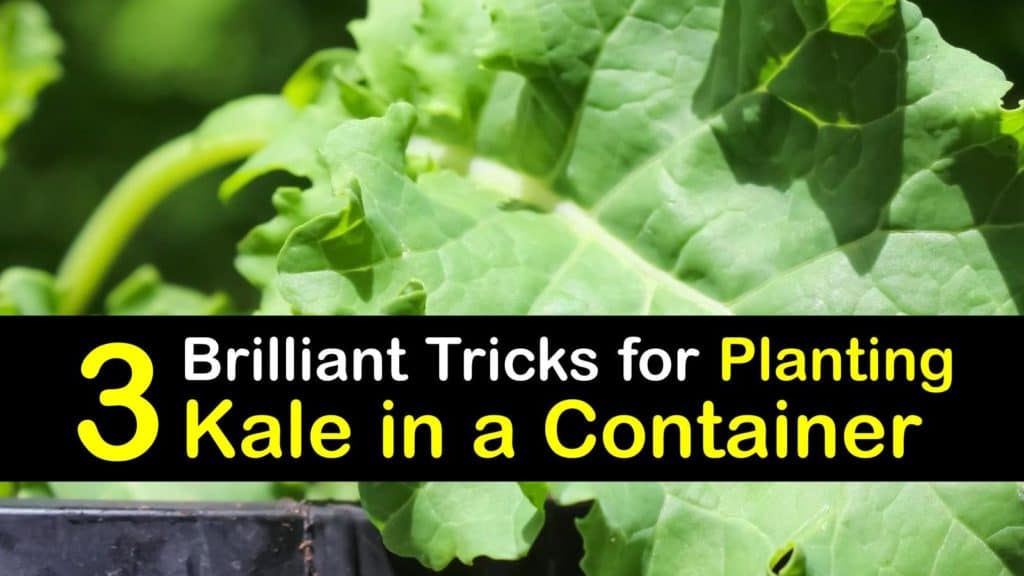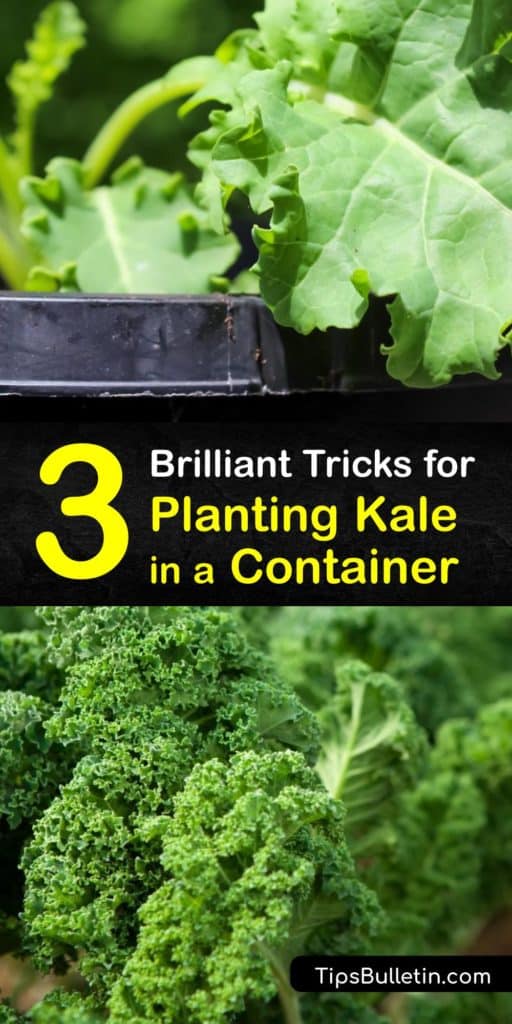Kale is one of the ultimate nutrient-dense leafy green veggies, and it’s also easy to grow. If you don’t have a garden or raised beds at home, don’t worry. In this article, you’ll learn how to grow kale in containers and keep it thriving in various conditions.
Both cabbage and kale go by the botanical name Brassica oleracea. Kale is in the Acephala group of the Brassica family, meaning it doesn’t form a central head.
It’s a biennial plant that develops leaves and roots during the first year and produces flowers and seeds the second year. Kale is remarkably cold-hardy and survives throughout the winter in many climates. Kale leaves become sweeter after a light frost.

Best Tips for Growing Kale in Containers
A superfood with a wide range of health benefits, kale contains numerous antioxidants, vitamins, and minerals. Regularly eating kale helps lower cholesterol, reduce inflammation, reinforce the immune system, and improve heart health.
Growing kale in containers or planting cabbage in containers allows you to relocate the pots and adapt to changing conditions throughout the kale growing season. It also helps minimize pest and disease issues that sometimes affect kale plants. There is not much difference between collard greens vs kale when considering their growing needs.
Although kale grows best in full sun with six or more hours of direct sunlight each day, it tolerates partial shade. However, the plants grow slower with less light.
A cool weather crop, the ideal temperatures for growing kale in a container range from 65-75℉. This pretty much follows the collard greens growing season, as well. The leaves keep growing as low as 20℉. Overwinter your kale pots by wrapping them in bubble wrap or old blankets, layering mulch on top, and storing them in a sheltered location.

A few kale plants provide an ample harvest for many months, making them some of the best veggies to grow in containers or in the garden. Pick the outer leaves as needed and allow the center to continue growing.
When you grow your own kale, it’s fun to try unusual and different varieties of kale that aren’t available at the supermarket. From dinosaur to curly kale, here are several of the top cultivars.
How to Grow Kale in Containers
Depending on your growing climate, there are several approaches to planting kale in containers or growing collard greens in containers.
The way to grow kale from seeds starts indoors six weeks before your average last frost date. Sow kale or collard seeds directly in your pots, or purchase seedlings from your local garden center.
Plant kale seeds a half-inch deep in a well-draining and nutrient-rich potting mix. It’s helpful to saturate the soil before planting seeds.
Kale seeds germinate fastest at temperatures between 60-70℉, typically emerging within a week. They’ll germinate as low as 45℉, but it takes longer in cold soil.
Once the seedlings sprout, ensure they receive at least six hours of direct sunlight daily. For the way to grow kale in a pot if you’re starting seeds indoors and don’t have a sunny windowsill available, consider using a grow light.
Kale seedlings should be six to eight inches tall and have at least two sets of true leaves before transplanting. Harden your seedlings off a week or two before transplanting them outdoors in early spring.
Begin harvesting kale microgreens once the leaves are two inches long. These small, tender leaves have a sweet flavor and mild texture. Continue picking the outer leaves as needed throughout the growing season.
Kale plants slow their leaf production during hot weather. Growth picks up again once temperatures cool off in late summer.
Choosing the Right Pot
When growing kale in containers, select a large enough pot for the root system to fully develop. Allow 12 inches of space per kale plant, and use a container that’s at least 12 inches deep with drain holes at the bottom to avoid fungal disease and rot.
Kale grows well with a variety of other plants. Leafy greens like lettuce, spinach, and Swiss chard have similar needs regarding light, nutrients, and water. Aromatic herbs and flowers like chives, cilantro, dill, marigolds, and Sweet Alyssum help attract beneficial insects and repel pests.
Best Fertilizer for Planting Kale in Containers
Kale plants are heavy feeders, so it’s beneficial to add nitrogen-rich fertilizer to your potting soil. For liquid plant fertilizer, feed your plants every two or three weeks according to the instructions listed on the product package. If you prefer using granular fertilizer, apply every four to six weeks.
Spread coffee grounds and eggshells around your kale plants. They help add nitrogen and other micronutrients to the soil and deter pests like snails and slugs.
Pest and Disease Problems for Kale Plants
While container gardening reduces the frequency of pest and disease issues, it’s still essential to monitor your plants for signs of distress. Their best defense against attacks from insects and pathogens is receiving the proper amounts of light, nutrients, and water.
Aphids, cabbage worms, cutworms, flea beetles, and leaf miners are some of the most frequent kale pests. To prevent insects from laying eggs on tender seedlings in the spring, cover your kale pots with row cover.
If you have severe problems with larval pests like cabbage worms and cutworms or need to get rid of cabbage aphids on kale, consider using a biological insecticide. Bacillus thuringiensis are naturally occurring soil bacteria that release proteins toxic to many types of insect larvae.
Neem oil is an excellent organic insecticide and fungicide. It effectively kills pests like aphids, flea beetles, and leaf miners, in addition to fungal diseases like mildew and rust.
To minimize the risk of plant disease, avoid overwatering and ensure that your plants get adequate airflow.
Container gardening is an outstanding way to grow your own groceries even when you don’t have a garden plot or raised beds at home.
Growing kale in containers is simple, and the delicious and nutritious results are worth the effort. All that’s required is a large enough pot and ample amounts of water and sunshine. Kale is an amazing addition to salads, smoothies, and stir fries.

If you found these tips for planting kale in containers helpful, please share this article about how to grow kale in containers with your fellow green thumbs on Pinterest and Facebook.